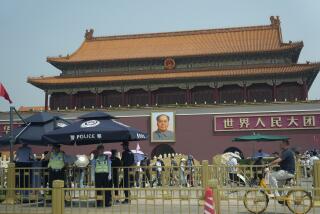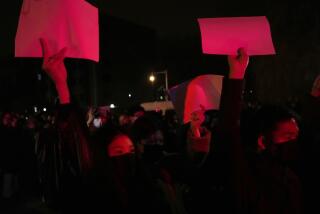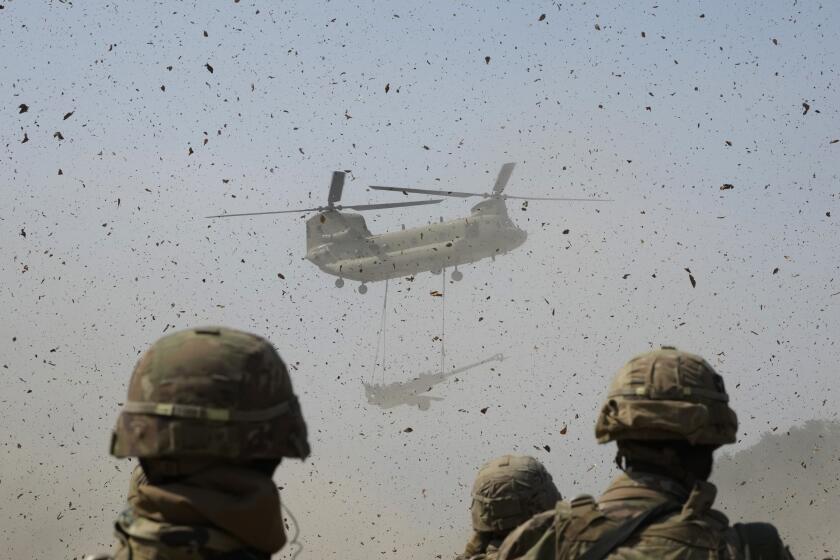ASIA : Tibet Braces for Anniversary of Chinese Rule : Tensions that brought rioting in recent years persist as authorities prepare for May’s observance of 40 years of control by Beijing.
- Share via
BEIJING — Shortly after dawn one recent morning, an American visitor to the Tibetan capital of Lhasa went walking near Jokhang Temple, a key center of Buddhist worship. Riot troops equipped with shields and helmets were stationed on the holy street ringing the temple. Armored vehicles could be seen nearby.
As morning activities picked up in the temple district’s warren of narrow lanes, the Chinese soldiers quietly melted away. But scattered on rooftops through the city, men armed with semiautomatic rifles provided a reminder to any potentially unruly Tibetans that greater force lurked just out of sight.
One year after the official lifting of martial law in Lhasa, there is no sign of an end to the religious, political and ethnic tensions that gave rise to anti-Chinese rioting, bloodily suppressed, in 1987, 1988 and 1989.
Authorities now are preparing for May celebrations to mark the 40th anniversary of the signing of a document confirming Beijing’s mastery of the vast Tibetan plateau, which stretches from the north slopes of the Himalayas to the deserts of central Asia.
Tibet was part of the Chinese empire during the Qing Dynasty, established by the Manchus of northeast China. It had effective independence for four decades after that dynasty’s 1911 collapse. The Communist Chinese army fought its way into the region in 1950. Troops did not reach Lhasa that year, but their presence in eastern Tibet helped pressure the Tibetan theocracy into accepting Chinese sovereignty in a document dated May 23, 1951.
Next month’s celebration of this so-called peaceful liberation of Tibet is part of a campaign to justify Chinese rule. But the staged events could provoke protests from Tibetans who see the festivities as forced celebration of their own subjugation.
Incidents in Tibet in recent weeks foreshadow the possibility of further clashes. Several hundred troops were used to suppress an anti-Communist protest in Gonjo county in eastern Tibet last month, according to reports that have filtered out of the region.
A tourist returning from Lhasa, quoted by Hong Kong’s South China Morning Post, told of another incident in which five monks were detained after staging a protest march around the Jokhang Temple on March 17. The monks had drawn a crowd that shouted slogans in praise of the Dalai Lama, Tibet’s exiled spiritual and political leader.
When James R. Lilley, the U.S. ambassador to China, visited Lhasa from March 29 to April 2, officials confirmed a recent small demonstration but provided no details, said a U.S. Embassy official.
The day before Lilley’s arrival in Lhasa, a group of men made a bold assault on a Chinese military arsenal in Lhasa, killing the guards and escaping with guns and ammunition, official Chinese reports said. Rumors of the raid swirled through the city during the American delegation’s visit, but official confirmation did not come until April 5.
Then, at a news briefing reported by official Lhasa radio, police announced that the arsenal of a unit of the Tibet Regional Military District was ransacked on March 28, when “soldiers guarding the arsenal were murdered; 19 pistols and 869 rounds of ammunition were stolen.”
In six days of investigation, police identified and arrested “the three principal criminals”--identified as Luo Pingyuan, Hu Lingchun and Li Yangbing. Six others accused in the case were detained for investigation; all of the stolen munitions were recovered, the radio reported.
As carried in Chinese-language reports, the three key suspects’ names seemed to mark them as ethnic Chinese. This left it unclear whether the incident had any connection with Tibetan nationalism, but it has clearly contributed to the nervousness of authorities.
The Dalai Lama may add to that anxiety during a visit to Washington next week, with a scheduled speech to Congress and dignitaries during a Capitol Hill visit. His last visit to Washington four years ago contributed to a tide of pro-independence fervor in Lhasa that erupted on Oct. 1, 1987, in anti-Chinese demonstrations and rioting.
Some Tibetans foresee deeper resentment and possible violence in the weeks ahead.
More to Read
Sign up for Essential California
The most important California stories and recommendations in your inbox every morning.
You may occasionally receive promotional content from the Los Angeles Times.











